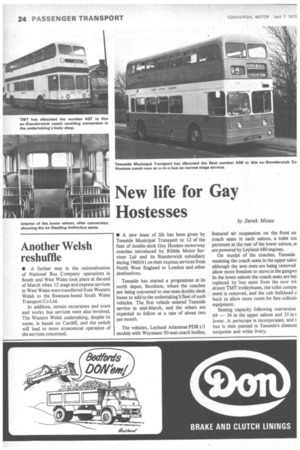war* New life for Gay Hostesses
Page 26

If you've noticed an error in this article please click here to report it so we can fix it.
by Derek Moses
Another Welsh reshuffle
• A further step in the rationalization of National Bus Company operations in South and West Wales took place at the end of March when 12 stage and express services in West Wales were transferred from Western Welsh to the Swansea-based South Wales Transport Co Ltd.
In addition, certain excursions and tours and works bus services were also involved. The Western Welsh undertaking, despite its name, is based on Cardiff, and the switch will lead to more economical operation of the services concerned. • A new lease of life has been given by Teesside Municipal Transport to 12 of the fleet of double-deck Gay Hostess motorway coaches introduced by Ribble Motor Services Ltd and its Standerwick subsidiary during 1960/61 on their express services from North West England to London and other destinations.
Teesside has started a programme at its north depot, Stockton, where the coaches are being converted to one-man double-deck buses to add to the undertaking's fleet of such vehicles. The first vehicle entered Teesside service in mid-March, and the others are expected to follow at a rate of about two per month.
The vehicles, Leyland Atlantean PDR 1/1 models with Weymann 50-seat coach bodies, featured air suspension on the front ax. coach seats in each saloon, a toilet cot partment at the rear of the lower saloon, ai are powered by Leyland 680 engines.
On receipt of the coaches, Teesside retaining the coach seats in the upper saloc although the arm rests are being removed allow more freedom to move in the gangwz In the lower saloon the coach seats are bei replaced by bus seats from the now wit drawn TMT trolleybuses, the toilet compai ment is removed, and the cab bulkhead c back to allow more room for fare col1ecti4 equipment.
Seating capacity following conversion 69 — 34 in the upper saloon and 35 in t lower. A periscope is incorporated, and t bus is then painted in Teesside's distincti turquoise and white livery.




















































































